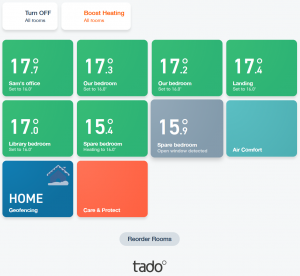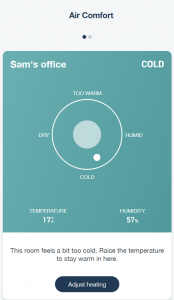Retrospective as 2021 comes to an end
Like many, this year has involved some changes health-wise (4 vaccinations, 3 for Covid-19 and one for influenza) and some sole searching following COP26.
COP? Police?
No, the climate crisess :D. For me, this has to be a personal thing. While governments and business can do their bit to ensure we can’t screw up, there are every day choices we need to be making every day.
One of the ones we made during October was the decision to change our themorstatic radiators values with “smart” ones from tado.
Is that complicated?
In many ways this is a much easier job than swapping a room thermostat and doesn’t require messing about with the boiler or power as thermostatic radiator valves are purely mechanical. You don’t even need to turn the radiators off, though we did, as it was October – just to make sure no-one got burnt!
The steps are then reasonably straight forward to follow. The receiver plugs into a power socket and using the phone app, we
plugged it into our hub router, automatically connecting it to tado’s servers to you can then drive everything from the tado app or web interface.
Then unscrew the existing valve in question (having let the radiator cool down), and after activating the battery, screw on the new thermostat.
In reality, the valve is untouched, what you’re swapping is just the thermostatic part. That means you don’t need any tools or plumbing knowledge – it also means you don’t need to pay “for installation services” unless you have no strength in your arms or difficulty sitting on the floor to reach the valves.
Once in situ, following the instructions help to pair the thermostat with the receiver. This is the time consuming bit and pretty much out of your control, you’re just waiting for connections and pairings.
What you end up with is a set of named thermostats, and a dashboard as below.
The menu boxes allow a comprehensive programming capability for each and every radiator – which is amazing where you have a single radiator in a room, a little harder to pair if you have more than one!
Savings? What’s the outcome?
There are a couple of things to note. One, to make the most of this, you need to pay a subscription annually. Two, it makes no sense to do that unless you have a smart phone that can tell the tado servers where you are.
The promises are high and we’re probably not making the best of the radiator thermostats as we don’t have the tado zone thermostat – it didn’t seem worthwhile to ditch our existing one as it’s still working and doesn’t require a battery.
We’re not achieving that, on average we’re saving 19% on our bills according to the phone app (18.3% in October, 9.3% in November), probably as you can see, I’m working from home which means we’re not out of the house much and needing to heat upstairs. It will detect open windows though and turn off a room while it deems a window to be open which is impressive.
But we’re getting quite a bit of extra information via the “air quality” menu.
This is interesting, not least as responsibility northern Europeans, we follow WHO guidelines and typically run our bedrooms between 15.6°C and 19.4°C, especially when sleeping. Tado quotes these values and ignores them, preferring rooms to be set at 20°C as an absolute minimum. Our rooms are typically called cold.
We also live in a humid climate in the winter – today, in my home town, the forecast states that humidity is 97%. My office, shown above, is running at 57%. At 60%, it would be deemed, humid, so 17.6°C and 57% is cold and getting humid, so it advises turning on the heating.
For guidence on what an ideal temperature for rooms in the UK, please check out this post: Viessmann – a boiler and radiator manufacturer.
If we turned on the heating to the settings they advise to be “pleasant” instead of cold, we’d be spending more than we did with the old thermostats!
You wouldn’t recommend it then?
If you ignore the whinges about temp and humidity, it is magic. Separately controlling the zone thermostat to the individual rooms, allows us to fine tune out climate indoors without crippling the wider environment. When rooms get to the right temperature but the zone thermostat is still on, the bathrooms are allowed to completely dry and stay toastie but not uncomfortable thanks to the zone thermostat.
To be honest, that is probably the best thing about the system. Complete tunability run to your spec, no waste.
It’s not cheap and it’s not an instant setup, it probably took a week to get it tuned to us with temperatures and times.
But when it’s done, it is amazing the difference it has made to our comfort without burning any more gas than we need to as an absolute maximum.
Merry Christmas.
Posted: December 18th, 2021 under 42, Driving off the grid.




